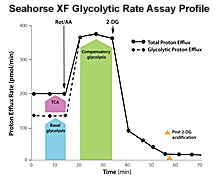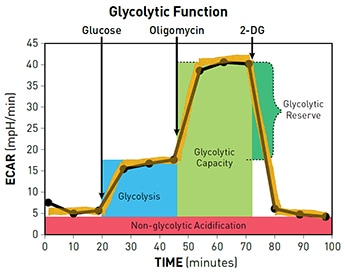The Agilent Advantage - Sensitive Real-Time Assays for Glycolysis

Glycolysis is the process by which glucose is broken down into components used for biosynthesis or energy production. Activation of this pathway in oxygen-abundant conditions, known as the Warburg effect, is associated with a variety of cellular functions such as proliferation, immune cell activation, and cancer.
Open a window to the earliest events and changes in
glycolysis through real time, live cell analysis
When glycolysis-derived lactate is exported from the cell, protons are also exported. Extracellular acidification rate (ECAR) is thus an indicator of glycolysis. Seahorse XF analyzers simultaneously measure this proton efflux as well as mitochondrial O2 consumption rate (OCR) to deliver a live-cell bioenergetic profile. Unlike endpoint assays such as lactate, XF analysis enables researchers to detect changes in metabolic function in real time, providing a window on the earliest events of metabolic switching.glycolysis through real time, live cell analysis
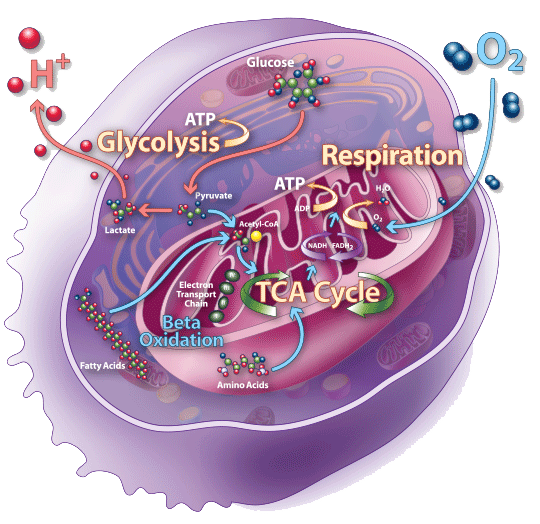
Introducing a new quantitative measure
of glycolytic rate
of glycolytic rate
In most cancer cell lines, the majority of acidification is due to glycolysis. In primary and other cell types however, mitochondrial activity that leads to CO2 production is a potentially significant source of extracellular acidification. Unlike bulk acidification assays, the Agilent Seahorse XF Glycolytic Rate Assay, with kits for both Seahorse XFe and Seahorse XFp Analyzers, is specific for glycolytic acidification. The XF Glycolytic Rate Assay uses both the OCR and ECAR (simultaneously measured by the Seahorse XF analyzer) to measure and subtract mitochondrial acidification, resulting in the glycolytic Proton Efflux Rate (glycoPER).
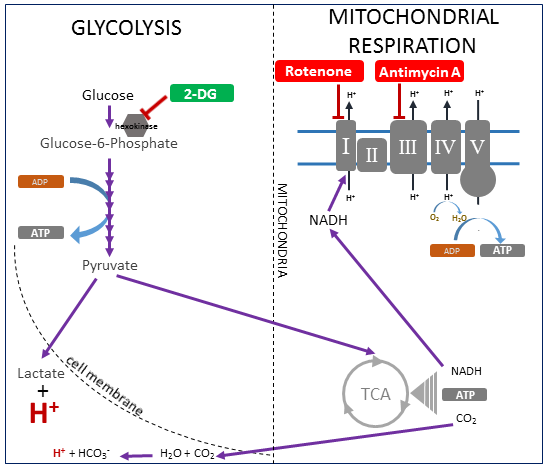
Seahorse Glycolytic Proton Efflux Rate
Directly Correlates to Lactate
Directly Correlates to Lactate
The XF Glycolytic Rate Assay has been designed to correlate with lactate accumulation assays, allowing scientists to cross validate results from different platforms. The key parameter of this assay, glycolytic Proton Efflux Rate (glycoPER), correlates 1:1 with lactate accumulation over time. For more information on the design and validation of the XF Glycolytic Rate Assay, download the white paper.
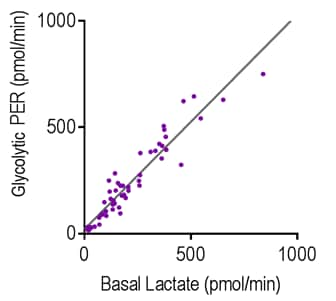
Options for Measuring Glycolysis: Physiological Rates or Pathway Capacity
All Seahorse XF Assays report extracellular acidification rate (ECAR) which is a convenient, real-time indicator of glycolysis suitable for relative measurements. For assessing specific aspects of glycolytic function, Agilent offers two assays that involve modulating cell function to extract richer information.
Table 1 Comparison chart of options to examine glycolysis with Seahorse XF technology.
| Extracellular Acidification Rate (ECAR) |
XF Glycolysis Stress Test |
XF Glycolytic Rate Assay |
|
| Detects acidification from all sources | ✔ | ✔ | ✔ |
| Accounts for mitochondrial CO2 - derived acidification | ✖ | ✖ | ✔ |
| Correlates directly with lactate accumulation | ✖ | ✖ | ✔ |
| Measures glycolysis in full substrate conditions | ✔ | ✖ | ✔ |
| Calculates percent of acidification coming from glycolysis | ✖ | ✖ | ✔ |
| Reports glycolytic reserve/capacity | ✖ | ✔ | ✖ |
| Best for | Simple monitoring of phenotypic switches | Biochemical studies | Physiological studies |
| Products Available | XFp Glycolysis Stress Test Kit XF/XFe Glycolysis Stress Test Kit |
XFp Glycolytic Rate Assay Kit XFe Glycolytic Rate Assay Kit |
The XF Glycolytic Rate Assay and XF Glycolysis Stress Test are available as kits for XFe96, XFe24, or XFp analyzers. Both kits provide pre-calibrated, pre-tested compounds and are coupled with powerful report generator software, making it easy to generate functional metabolic data. These kits work best when used with Seahorse XF Media.
Seahorse XF Media
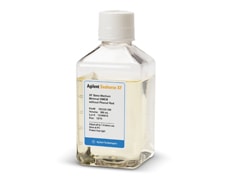
Seahorse XF media is specially formulated for Seahorse XF assays. Media without Phenol Red is required for the Glycolytic Rate Assay, as is 1M HEPES.
Related Information
Learn more about How XF technology Works.
Browse peer-reviewed publications containing Seahorse XF data with our Publications Database.
Find out how XF technology has been used with different cell types of interest with our Cell Reference Database.
For Research Use Only. Not for use in diagnostic procedures.
